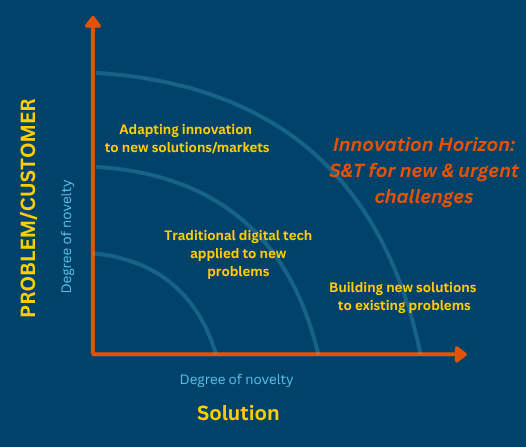What are deep-tech startups?
Written By: Karsten Heise, Senior Director of Strategic Programs & Innovation
Again, this autumn was the season for Startup Week in both Las Vegas and Reno. GOED’s Office of Entrepreneurship, under the leadership of Melissa Saavedra, was involved in the planning and organizing of both events, which included two panels that featured deep-tech startups and representatives from relevant support organizations. 
This gives us an opportunity to drill a bit deeper into this topic of deep-tech firms and startups. Best to start off with some definitions of what exactly constitute a “deep-tech” or also known as “tech-based” company or startup.
What are “deep tech” firms?
“Deep-tech firms create entirely new industries and markets and have tremendous impact shaping our futures.”
Generally speaking, deep-tech companies are grounded in innovation. We at GOED’s Innovation Based Economic Development division, or IBED for short, have adopted the MIT definition of innovation[1], which is simply the “process of taking ideas from inception to impact.” Note that this does not specifically mention technology or science, which is why we called our division Innovation Based Economic Development and not Technology Based Economic Development. We wanted it to be clear that innovation is a different concept, even if it utilizes technologies. Entrepreneurs can be innovative without necessarily requiring the application of technology.

All that said, when we talk about deep-tech firms we mean those that are developing innovative solutions based on new technologies and science. But technology itself is not enough. Deep–tech firms and startups are positioned on what we call the “technology frontier,” or “innovation horizon.” That is, they develop solutions for highly novel and urgent, often global, challenges instead of just adopting innovation to new markets or providing new solutions to existing problems. As such, they can create entirely new industries and markets that have tremendous impact on shaping our futures. Those firms often develop their solutions in conjunction with universities or national laboratories.
By contrast, firms that apply digital technologies to new problems, although e.g. potentially groundbreakingly changing how we consume, would not be categorized as deep-tech.
Having defined what constitutes deep-tech firms or startups, what makes them different and why does that matter?
“To succeed, deep-tech firms require very specific elements.”
The main difference lies in the types of risk associated with deep-tech firms. While startups and high-growth firms can get the support they need in local entrepreneurial ecosystems, deep-tech firms have much more specific needs.
An entrepreneurial ecosystem is typically a specific geographic area that through its members – both institutions as well as individuals – fosters the creation and growth of startups and small businesses. This is achieved by harnessing networks located within the geographic area comprising for example, customers, mentors, providers of risk capital, other entrepreneurs, universities and research organizations, established corporations, various entrepreneurial support organizations (such as incubators and accelerators), professional and legal service providers etc.
Why do startups, early-stage, and high-growth firms need to be embedded in such ecosystems in the first place?
To answer this would require us to invoke the definition of entrepreneurship which GOED’s Office of Entrepreneurship has adopted as its guide. Professor Howard Stevenson of Harvard Business School has coined that entrepreneurship “is the pursuit of opportunity beyond resources controlled”.
In other words, an entrepreneur building her company does not have all the resources she needs. The ability of an ecosystem to provide entrepreneurs with those resources will play a crucial role in determining the success of a company. At the same time, it will also measure the quality of the ecosystem itself and its ability to create, grow and attract founders and startups.
Deep-tech firms, and startups in particular, require more specialized resources than can be found in more “standard” entrepreneurial ecosystem since they benefit from access to technology, or science-based support structures. For example, building and scaling deep-tech companies will entail going through a long and deep “valley of death.” After the academic value of a technological invention is exhausted, only then can the transformation to commercial value begin. Because the relevant technology is typically developed by individual researchers or research teams, an external assessment of the viability and its potential is difficult to make. Economists call this “information asymmetry.” This can make it difficult to raise the necessary risk capital from private capital providers. That’s where early-stage, non-dilutive capital such as federal, state, and other research and development grants can play an important role
Invented technologies based on scientific research must be consistently developed along a Technology Readiness Level spectrum (TRL), progressing from validating the technology, scaling from laboratory conditions to non-laboratory environments, developing prototypes, and manufacturing at larger scale. Each of those stages is often associated with specific funding sources.
This means that in contrast to an ordinary startup, which typically builds a minimum viable product and follows the principal of “failing fast,” a deep-tech firm is building “minimum viable pathways” consisting of milestones along those paths. On those paths they encounter a variety of risks: Technology development and engineering risks with challenges of manufacturing and scaling which makes deep-tech firms much more intensive in their capital expenditure than other ventures. This would also require developing a comprehensive understanding of supply chains and their associated constraints. Because the technologies developed are novel and tackle global challenges, they open entirely new domains that often result in regulatory risks, including potentially complex certification requirements.
“The nature and composition of ecosystems are essential, and resources must be available to match those respective needs.”
For all these reasons, deep-tech companies are inherently exhibiting a much higher degree of risk and therefore must be embedded in ecosystems that provide resources to position individual firms to better meet and navigate those unique risk profiles in order for them to succeed. For example, universities can not only provide engineering and science talent but also access to shared used facilities like laboratories, testing equipment and faculty expertise. Universities play a unique role in providing testbeds to support deep-tech companies meeting their respective milestones on their minimum viable pathway trajectory. Our state-sponsored venture capital program has provided risk capital to technology-intensive startups while GOED is additionally supporting these firms through projects sponsored by the Knowledge Fund where the research universities provide validation and testing and other research and development services crucial for product development, often also linked to additional federal non-dilutive grant funding, such as SBIR/ STTR. Federal agencies: DoD, DoE, NSF etc. are increasingly requiring industry-academic partnership for landing large grant opportunities.
Established corporations also play a vital role within the ecosystem. They can help deep-tech firms with sharing supply chain insights, navigate manufacturing risks and crucially can act as first local customers.
So, why is this all important?
After going through all this background, you may wonder why you should care about tech-based firms. Academic studies[2], such as research conducted by Berkeley’s Professor Enrico Moretti, found that “for each new high-tech job in a city, five additional jobs are ultimately created outside the high-tech sector in that city. This is about three times larger than in manufacturing” […]
The bottom line is that “fostering the growth of innovative and tech-based enterprises is a smart and effective economic development strategy.”
GOED’s IBED emphasizes understanding the different needs of small businesses, namely small and medium-sized enterprises, and innovation-driven enterprises, the latter including deep-tech enterprises. Elaborating on this distinction will be a topic for a future blog.
Our Office of Entrepreneurship and dedicated programs within IBED such as the Knowledge Fund and the State Small Business Credit Initiative (SSBCI) Program, “Battle Born Growth”, offer support mechanisms that are designed to strengthen Nevada’s ecosystems by offering tailored resources that those different types of businesses would otherwise have only limited or even no access to.
The example of deep-tech firms offers insights into how their unique characteristics produce subsequent unique needs that require a very specific support fabric so that technology-based firms will be created, grow and thrive at scale.
That necessitates that GOED will have the tools to strengthen such support fabrics, which in turn requires sufficient and continued federal program funding and dedicated Nevada legislative appropriations to ensure sustainability.
[1] Phil Budden and Fiona Murray, An MIT Approach to Innovation: eco/systems, capacities & stakeholders, MIT Lab for Innovation Science and Policy, Working Paper, October 2019
[2] Enrico Moretti, The Multiplier Effect of Innovation Jobs, MIT Sloan Management Review, 2012


